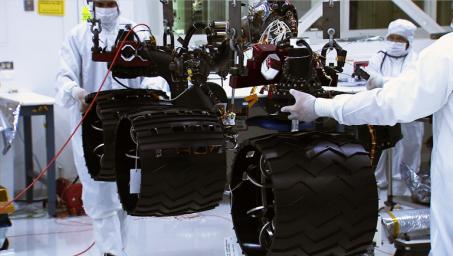
|
New Wheels
- Click the image above for a larger view
- Full-Res JPEG (1904 x 1075) (266.6 kB)
- Full-Res TIFF (1904 x 1075) (6.1 MB)
Caption:
In this picture, engineers are preparing Curiosity's wheels for installation. Six new wheels were installed onto the rover on June 28 and 29, in the Spacecraft Assembly Facility at NASA's Jet Propulsion Laboratory, Pasadena, Calif., where the rover is being assembled.
These wheels are 50 centimeters (20 inches) in diameter, making them larger than the wheels of a car. Each wheel has its own motor, giving the rover independent six-wheel drive. The rover can swerve and turn in place a full 360 degrees. The suspension system is based on the "rocker-bogie" system, which was used on the Spirit and Opportunity rovers and the earlier Pathfinder missions. This system allows the rover can roll over large rocks and dips without tipping over. The rover can also climb steep hills, up to 45 degrees. Curiosity's wheels have "cleats," similar to those soccer players have on their shoes, which provide grip and prevent the rover from slipping while going over rocks or climbing up hills of soft sand.
Background Info:
Curiosity is the centerpiece of NASA's Mars Science Laboratory mission, which is expected to launch in late 2011, and touch down wheels-first in summer 2012.
Cataloging Keywords:
| Name | Value | Additional Values |
|---|---|---|
| Target | Mars | |
| System | ||
| Target Type | Planet | |
| Mission | Mars Science Laboratory (MSL) | Mars Exploration Rover (MER) |
| Instrument Host | Curiosity Rover | Opportunity (MER-B), Spirit (MER-A) |
| Host Type | Rover | |
| Instrument | ||
| Detector | ||
| Extra Keywords | Color | |
| Acquisition Date | ||
| Release Date | 2010-07-07 | |
| Date in Caption | ||
| Image Credit | NASA/JPL-Caltech | |
| Source | photojournal.jpl.nasa.gov/catalog/PIA13236 | |
| Identifier | PIA13236 | |
